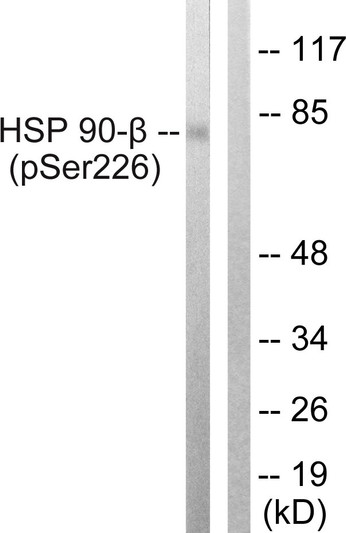| Function | Molecular chaperone that promotes the maturation, structural maintenance and proper regulation of specific target proteins involved for instance in cell cycle control and signal transduction. Undergoes a functional cycle linked to its ATPase activity. This cycle probably induces conformational changes in the client proteins, thereby causing their activation. Interacts dynamically with various co-chaperones that modulate its substrate recognition, ATPase cycle and chaperone function. Engages with a range of client protein classes via its interaction with various co-chaperone proteins or complexes, that act as adapters, simultaneously able to interact with the specific client and the central chaperone itself. Recruitment of ATP and co-chaperone followed by client protein forms a functional chaperone. After the completion of the chaperoning process, properly folded client protein and co-chaperone leave HSP90 in an ADP-bound partially open conformation and finally, ADP is released from HSP90 which acquires an open conformation for the next cycle. Apart from its chaperone activity, it also plays a role in the regulation of the transcription machinery. HSP90 and its co-chaperones modulate transcription at least at three different levels. They first alter the steady-state levels of certain transcription factors in response to various physiological cues. Second, they modulate the activity of certain epigenetic modifiers, such as histone deacetylases or DNA methyl transferases, and thereby respond to the change in the environment. Third, they participate in the eviction of histones from the promoter region of certain genes and thereby turn on gene expression. Antagonizes STUB1-mediated inhibition of TGF-beta signaling via inhibition of STUB1-mediated SMAD3 ubiquitination and degradation. Promotes cell differentiation by chaperoning BIRC2 and thereby protecting from auto-ubiquitination and degradation by the proteasomal machinery. Main chaperone involved in the phosphorylation/activation of the STAT1 by chaperoning both JAK2 and PRKCE under heat shock and in turn, activates its own transcription. Involved in the translocation into ERGIC (endoplasmic reticulum-Golgi intermediate compartment) of leaderless cargos (lacking the secretion signal sequence) such as the interleukin 1/IL-1.the translocation process is mediated by the cargo receptor TMED10. (Microbial infection) Binding to N.meningitidis NadA stimulates monocytes. Seems to interfere with N.meningitidis NadA-mediated invasion of human cells (Probable). |
| Protein Name | Heat Shock Protein Hsp 90-BetaHsp 90Heat Shock 84 KdaHsp 84Hsp84Heat Shock Protein Family C Member 3 |
| Database Links | Reactome: R-HSA-168928Reactome: R-HSA-2029482Reactome: R-HSA-3371497Reactome: R-HSA-3371511Reactome: R-HSA-3371568Reactome: R-HSA-3371571Reactome: R-HSA-399954Reactome: R-HSA-5336415Reactome: R-HSA-6798695Reactome: R-HSA-844456Reactome: R-HSA-8852276Reactome: R-HSA-8937144Reactome: R-HSA-8939211Reactome: R-HSA-9013418Reactome: R-HSA-9018519Reactome: R-HSA-9613829Reactome: R-HSA-9660826Reactome: R-HSA-9679191Reactome: R-HSA-9705671Reactome: R-HSA-9820962Reactome: R-HSA-9834752 |
| Cellular Localisation | CytoplasmMelanosomeNucleusSecretedCell MembraneDynein Axonemal ParticleCell SurfaceIdentified By Mass Spectrometry In Melanosome Fractions From Stage I To Stage IvTranslocates With Birc2 From The Nucleus To The Cytoplasm During DifferentiationSecreted When Associated With Tgfb1 Processed Form (Lap) |
| Alternative Antibody Names | Anti-Heat Shock Protein Hsp 90-Beta antibodyAnti-Hsp 90 antibodyAnti-Heat Shock 84 Kda antibodyAnti-Hsp 84 antibodyAnti-Hsp84 antibodyAnti-Heat Shock Protein Family C Member 3 antibodyAnti-HSP90AB1 antibodyAnti-HSP90B antibodyAnti-HSPC2 antibodyAnti-HSPC3 antibodyAnti-HSPCB antibody |
Information sourced from Uniprot.org












